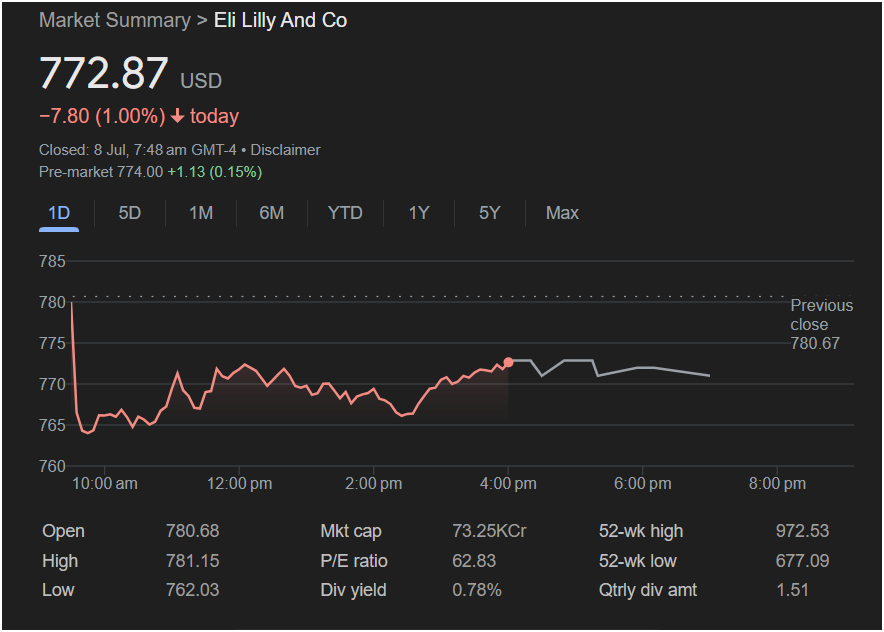Eli Lilly’s Wild Ride: Stock Plummets 1% After Sharp Intraday Nosedive, High-Stakes Volatility Grips Pharma Giant

Indianapolis, IN – Shares of pharmaceutical behemoth Eli Lilly and Co. (NYSE: LLY) concluded a tumultuous trading session on July 8th, leaving investors with a sense of whiplash and a clear reminder of the high-stakes game surrounding one of the market’s most-watched stocks. The company closed the day at
7.80, or a full 1.00%. This seemingly straightforward decline, however, belies a day of extreme intraday volatility that saw the stock plunge dramatically before clawing back a substantial portion of its losses in a hard-fought recovery.
The day’s trading was a textbook case of a growth stock’s sensitivity to market sentiment. Eli Lilly opened the session at $780.68, almost precisely at its previous closing price of
781.15**, the floor gave way.
The stock plummeted throughout the morning, carving a stark, downward-sloping line on the intraday chart. This intense selling pressure culminated in the stock hitting its session low of $762.03. This marked a staggering drop of over $19 from its high, representing a painful 2.45% intraday decline. For investors, this moment was a critical test of nerve, as the sell-off raised questions about the stability of the stock’s lofty valuation.
However, as the market moved into the afternoon, a new dynamic emerged. Buyers, potentially seeing the deep discount as a strategic entry point, began to re-enter the market. A period of accumulation began, sparking a choppy but determined recovery. The stock fought its way back, navigating a saw-toothed pattern of advances and pullbacks, eventually moving well clear of its intraday lows. Despite this impressive rebound, the bullish momentum was not enough to overcome the morning’s damage. The recovery rally stalled out in the late afternoon, and the stock was unable to reclaim the breakeven point set by the previous day’s close.
As the dust settled, the closing price of
1.13 (0.15%)** to $774.00, hinting that the battle for control between bulls and bears is far from over.
Decoding the Numbers: A Deep Dive into Eli Lilly’s Fundamental DNA
To comprehend the forces driving such volatility, one must look beyond the daily price action and analyze the fundamental metrics that define Eli Lilly’s unique position in the market. These figures explain both the immense optimism surrounding the company and the inherent risks that come with it.
The Stratospheric Valuation: A P/E Ratio of 62.83
The most striking number on Eli Lilly’s data sheet is its Price-to-Earnings (P/E) ratio of 62.83. This figure is exceptionally high, dramatically outpacing the S&P 500 average (typically in the 20s) and the broader pharmaceutical sector. A high P/E ratio signifies that investors are willing to pay a significant premium for each dollar of the company’s current earnings.
This isn’t a sign of irrationality; it’s a bet on explosive future growth. The entire market narrative for Eli Lilly is built upon the monumental success and future potential of its GLP-1 drugs, primarily Mounjaro (for type 2 diabetes) and Zepbound (for weight loss). These drugs are considered revolutionary and are projected to generate tens of billions of dollars in annual revenue, fundamentally reshaping the company’s earnings profile. Investors are pricing the stock not on its 2024 earnings, but on its anticipated earnings in 2028, 2030, and beyond.
However, this high-growth narrative is a double-edged sword. It makes the stock incredibly sensitive to any news that could threaten that future growth story. Competitor advancements, regulatory hurdles, pricing pressures, or even a slight miss on quarterly expectations can trigger the kind of sharp, aggressive sell-off seen today as investors rapidly reassess whether the premium valuation is still justified.
A Market Colossus: The Staggering Market Capitalization
The displayed market cap of “73.25KCr” translates from the Indian numbering system to a colossal $732.5 billion in U.S. dollars. This places Eli Lilly in an elite club of the world’s most valuable companies, having surpassed giants like Tesla in market capitalization. This immense size reflects the market’s conviction in its drug pipeline. It has become a heavyweight component of major indices, meaning its movements can have a tangible impact on the broader market. The day’s 1% drop wiped out over $7 billion in market value, illustrating the scale at which this stock operates.
A Growth Stock’s Dividend: Yield at 0.78%
For income-seeking investors, Eli Lilly offers a modest dividend yield of just 0.78%, based on a quarterly payout of $1.51 per share. This low yield is characteristic of a high-growth company. Rather than distributing a large portion of its profits to shareholders, Eli Lilly is reinvesting its capital heavily into research and development (R&D), manufacturing expansion to meet overwhelming demand for its new drugs, and marketing efforts. Investors in LLY are typically prioritizing capital appreciation—the growth of the stock price itself—over immediate income, and they expect the company to use its cash to fuel the growth that underpins its high valuation.
Navigating the Annual Range: 52-Week High and Low
The stock’s 52-week range provides critical context for the day’s trading. The annual high stands at a dizzying
677.09. The closing price of $772.87 places the stock in the lower half of this range, approximately 20% off its all-time high. This indicates that the stock has already been in a corrective phase, pulling back from the peak euphoria seen earlier in the year.
The day’s low of $762.03 was a crucial test. It brought the stock closer to the midpoint of its annual range, a level where technical support is often found. The strong rebound from this low suggests that institutional buyers and long-term believers in the company’s growth story view these significant pullbacks as buying opportunities, providing a floor under the price. The path back to the $972 high appears long, but the defense of the $762 level is a positive short-term signal for the bulls.
The Road Ahead: Key Levels and Lingering Questions
As investors look toward the next trading session, the day’s volatile action has established clear technical battlegrounds. The pre-market uptick to $774.00 offers a tentative dose of optimism, but the stock will face immediate challenges.
The first major hurdle will be reclaiming the previous day’s close of
762.03 now stands as a critical line in the sand. A breach of this support level could open the door to a deeper correction, potentially targeting lower support zones.
The session leaves the market with pressing questions: Was this sharp sell-off simply a case of profit-taking in a high-flying name, or does it signal a more fundamental shift in investor sentiment? Will the positive pre-market indication translate into real buying pressure at the open? In the high-stakes, high-volatility world of Eli Lilly stock, the one certainty is that the market will be watching its next move with bated breath.






